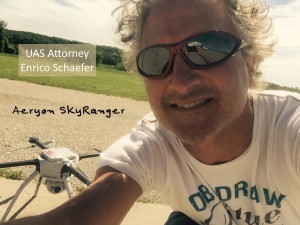As it currently stands, getting a Section 333 exemption from the FAA is the only legitimate way to make money flying a drone. While the number of exemptions the FAA has granted is increasing, the process is still complex, time consuming, and expensive.
This is where companies like DroneLaw.Pro come in. Headquartered in Traverse City, MI, DroneLaw.Pro is a team of lawyers who specialize in aviation, specifically in getting companies a 333 exemption.
In fact, they guarantee their clients get FAA approval.
Getting a Section 333 Exemption with DroneLaw.Pro
Now, any reasonable person on the internet reads the word guarantee and is immediately filled with suspicion. And while there is no catch to DroneLaw.Pro’s promise, there is much more to the process than simply hiring a law firm to get a Section 333 exemption.
 “A lot of the companies who call us are still in the gathering information phase,” DroneLaw.Pro’s founder, Enrico Schaefer told DroneLife in a recent interview. “That’s why we offer unlimited free consultation to make sure a 333 is right for you. Realistically, if you are serious about starting a company with drones, you are going to need a minimum of $10,000 for marketing, processing, hardware costs, legal, and insurance (which isn’t mandatory but is highly recommended).”
“A lot of the companies who call us are still in the gathering information phase,” DroneLaw.Pro’s founder, Enrico Schaefer told DroneLife in a recent interview. “That’s why we offer unlimited free consultation to make sure a 333 is right for you. Realistically, if you are serious about starting a company with drones, you are going to need a minimum of $10,000 for marketing, processing, hardware costs, legal, and insurance (which isn’t mandatory but is highly recommended).”
The other issue that comes up in the consulting phase is the fun fact that even if you are granted an exemption, there are a lot of provisions that come with it; the least expected and most frustrating of which is the fact that you will need a licensed pilot present whenever you want to fly.
“The FAA takes two to three months to process a 333 request. In that time, we help companies build business models and discuss how these companies will comply with the conditions and limitations of the exemptions,” Schaefer said. “The biggest issue is 80% of our clients don’t have pilot’s licenses so companies need to decide if they are going to get one or contract licensed pilots.”
“The other provision that proves difficult is you have to keep your aircraft away from crowds. This is especially troublesome for our clients in the real estate business. As a business, you want your customer to tell their neighbors there will be a drone flying around. There is no way to be 100% compliant in cases like this -someone could wander over into your designated flying area- but it’s all about mitigating risk.”
Calculating the Risk
 The truth is, the FAA doesn’t have the time or the resources to police everyone who goes out and starts taking monetary compensation for flying their drone.
The truth is, the FAA doesn’t have the time or the resources to police everyone who goes out and starts taking monetary compensation for flying their drone.
As long as you don’t go posting your watermarked videos all over the internet and you avoid damaging someone’s person or property, you should be able to stay off the FAA’s radar.
But there are always unforeseen factors that can increase your risk.
In fact, the way most pilots without a 333 Exemption have gotten noticed by the FAA, according to Schaefer, is by being notified by an exempt competitor.
“In some cases, the exemption is being used as a market barrier,” Schaefer explained. “90% of the people who tell us they have been contacted by the FAA say it’s because a competitor notified the administration.”
The FAA will give you one warning, according to Schaefer, and that’s the point a lot of his clients begin looking for help.
Of course, the process will change once the FAA eventually publishes true regulations and there is a clear path to legally flying a drone ‘for commercial purposes.’
Until then, you can hone you skills as a private company and keep it all on the down low, or you can consult with Schaefer and his team at DroneLaw.Pro:
